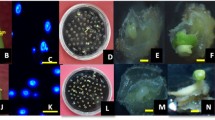Summary
Androgenesis occurred from chile pepper (Capsicum annuum L.) anthers incubated in a continuous warm environment (29° C) with continuous light. Forty plantes and embryoids were retrieved from anther cultures and anllyzed for isozyme markers. Of these, 35 exhibited a single allele for markers suggesting microspore origin, while 5 were heterozygous indicating somatic tissue origin. Chromosome numbers were confirmed for 21 plantlets, of which 16 were haploid and 5 were diploid. However, two plants exhibited a single allele for an isozyme marker but possessed the diploid chromosome number, suggesting spontaneous doubling. Anther cultures also produced callus. Nearly 92% of the slow-growing calli sampled were heterozygous for the isozyme marker, suggesting somatic tissue origin. More than 46% of the fast-growing calli exhibited only one allele for the marker, indicating microspore origin. Callus did not regenerate plantlets. The occurrence of both heterozygous and homozygous diploid plantlets from pepper anther cultures has important implications for applied breeding programs.
Similar content being viewed by others
References
Borromeo, C. R. Sowing orchid seeds the easiest way. Orchid Soc. Bull., Nov.: 983–987; 1973.
Dumas de Vaulx, R.; Chambonnet, D.; Pochard, E. Culture in vitro d'antheres de piment (Capsicum annuum L.): amelioration des taux d'obtention de plantes chez differents gynotypes par des traitements a +35° C Agronomie 1:859–864; 1981.
Fari, M. Pepper (Capsicum annuum L.) In: Bajaj, Y. P. S., ed. Biotechnology in agriculture and forestry 2: Crops L. Berlin, Heidelberg: Springer-Verlag; 1986:345–362.
Gamborg, O. L.; Miller, R. A.; Ojima, K. Nutrient requirements of suspension cultures of soybean root cells. Exp. Cell Res. 50:151–158; 1968.
Kuo, J. S.; Wang, Y. Y.; Chien, N. F.; Ku, S. J.; Kung, M. L.; Hsu, H. C. Investigations on the anther culture in vitro ofNicotiana tabacum L. andCapsicum annuum L. Acta Bot. Sinica 15:47–52; 1973.
Morrison, R. A.; Koning, R. E.; Evans, D. A. Pepper. In: Evans, D. A.; Sharp, W. R.; Ammirato, P. V., eds. Handbook of plant cell culture. Techniques and applications, vol. 4. New York: Macmillan; 1986:552–573.
Marashige, T.; Skoog, F. A reviesed medium for rapid growth and bioassays with tobacco tissue cultures. Physiol. Plant. 15:473–497; 1962.
Novak, F. J. Induction of a haploid callus in anther cultures ofCapsicum sp. Z. Pflanzensucht. 72:46–54; 1974.
Phillips, G. C.; Collins, G. B. In vitro tissue culture of selected legumes and plant regeneration from callus cultures of red clover. Crop Sci. 19:59–64; 1979.
Sibi, M.; Dumas de Vaulx, R.; Chambonnet, D. Obetention de plantes haploides par androgenese in vitro chez le piment (Capsicum annuum L.). Ann. Amelior. Plant 29:583–606; 1979.
Tanksley, S. D. Linkage relationships and chromosomal locations of enzyme-coding genes in pepper,Capsicum annuum. Chromosoma 89:325–360; 1984.
Vallejos, C. E. Enzyme activity staining. In: Tanksley, S. D.; Orton, T. J., eds. Isozymes in plant genetics and breeding, part A. Amsterdam: Elsevier; 1983:469–516.
Wang, Y. Y.; Sun, C. S.; Wang, C. C.; Chien, N. F. The induction of the pollen plantlets of triticale andCapsicum annuum from anther culture. Sci. Sinica 16:147–151; 1973.
Author information
Authors and Affiliations
Rights and permissions
About this article
Cite this article
Munyon, I.P., Hubstenberger, J.F. & Phillips, G.C. Origin of plantlets and callus obtained from chile pepper anther cultures. In Vitro Cell Dev Biol 25, 293–296 (1989). https://doi.org/10.1007/BF02628469
Received:
Accepted:
Issue Date:
DOI: https://doi.org/10.1007/BF02628469




